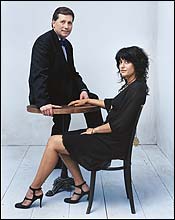
Medical Miracle #1
Problem: Thirty-five-year-old artist preparing for first museum exhibit. Leans forward while working and feels sharp pain in hip. X-rays show a cancerous bone tumor. She’s told she may lose her leg—and her life.
Doctor: John Healey
Patient: Luisa Kazanas
In the fall of 2003, Luisa Kazanas was sitting cross-legged on the floor of her Williamsburg studio preparing for her first major museum exhibition at the Cranbrook Art Museum near Detroit. The 35-year-old artist’s work includes exquisitely fanciful sculptures of torsos and body parts, some so large that they require ladders for her to complete—but that day, part of Kazanas’s own body rebelled against her when she leaned forward to grab a heavy mold and felt a searing pain in her left hip. Kazanas had thought she’d pulled something a few days earlier during her day job as a music-video art director, but this, she sensed, was much more serious. “The next day, I could only put 30 percent of my weight on that leg,” she recalls. Kazanas saw a sports orthopedist who X-rayed her and detected what he called “a four-inch lesion” on her left femur. “I’m like, ‘Oh, you mean tumor?’ ” she remembers. “And he says, ‘Well, let’s not make any assumptions,’ and I’m like, ‘I’m looking at the frigging tumor in my bone, and you’re telling me I don’t have bone cancer?!’ ”
A week later, a biopsy confirmed that the mass in that X-ray was indeed cancerous. Kazanas was placed in a full body cast, to protect the structural integrity of her leg. “I was a plank of wood,” she says. Surgery would require cutting out a large amount of cancerous bone and muscle, and that would be the good news: Doctors were preparing her for two years of chemo and radiation that would have little chance of saving her life, much less her leg. Kazanas couldn’t see living without the use of her legs. “I’m a sculptor,” she says. “You can’t separate my physicality from my identity.”
Kazanas couldn’t see living without the use of her legs. “I’m a sculptor,” she says. “You can’t separate my physicality from my identity.”
Friends helped her find John Healey, an orthopedic surgeon at Memorial Sloan-Kettering who specializes in repairing and maximizing the use of limbs afflicted by cancer. Reanalyzing her charts and her biopsy, Healey diagnosed Kazanas with leiomyosarcoma, a rare soft-tissue cancer that sometimes appears in bone. And although a team at another hospital recommended replacing Kazanas’s hip and leg with just metal—an option that might not leave her with enough muscle to walk—Healey suggested something more radical: combining metal with human bone donated from bone banks. Healey explained that human bone is easier than metal to attach to human muscle, giving Kazanas a fighting chance at using what muscle she’d have left to support her weight and walk. The downside: The surgery would be more complicated and riskier, with an increased chance of infection. “To do this work, you have to suspend your disbelief,” says Healey, whose work often demands a certain flair for improvisation. “The very first hip replacement,” he says, “was done not because of arthritis but because of a tumor not unlike Luisa’s.”
Over eight hours in the OR, Healey worked on Kazanas’s left hip and leg not unlike a sculptor would, cutting out cancerous bone and muscle and meticulously tailoring six inches of replacement bone along with eighteen inches of titanium to fit her with a new hip and femur. Three months of rest and physical therapy later, Kazanas was swimming and walking with crutches. Today, “I’m probably about 80 percent functional,” she says. “There are no crutches. If I have to walk for a while, I take a cane.” Best of all, she’s back to work; she can even climb ladders in her studio to continue making her sculptures.
Kazanas’s Detroit museum show was postponed to last December, but then went off without a hitch—thanks in part to the artistry of her surgeon. “Dr. Healey basically bungeed my muscles to allow the leg to function,” Kazanas says. “He’s creative, he’s humane. But more than that, he treats the cancer as his dragon to slay. He takes it personally, and that was important to me. I didn’t want to feel like just another limb to be reconstructed, and he never saw it that way.”